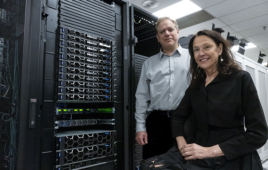
Image courtesy of Pixabay
Continued innovations in bioinformatics paired with the falling cost of DNA sequencing are poised to spur research breakthroughs in 2023.
To gauge how the DNA sequencing field is likely to evolve, we reached out to Logan Zinser, SVP, finance, Element Biosciences and Keith Robison, principal engineer, NGS Computational Biology, Ginkgo Bioworks. In the following feature, the two muse on themes ranging from the growing availability of next-generation sequencing and multiplex testing.
1. Falling DNA sequencing costs will empower the data-savvy
As the costs of DNA sequencing continue to fall, companies will do more sequencing.
“At Element, we are enabling our customers to generate a tremendous amount of high-quality genomic data at an unprecedented price, so the challenge shifts toward making sense of those data,” Zinser said. “Working with our customers and partners, we are leveraging advances in machine learning and artificial intelligence to assist in interpreting the big data generated by our sequencers.”

Keith Robison
Robinson had a similar take. “The dropping cost per base of DNA sequence will be most valuable to those who can extract a large amount of valuable data from each sequencing experiment and apply that to their problem space,” he said.
The falling cost of sequencing will make it possible to sequence more individual samples, examine more replicates of the same sample, explore more conditions in a process and go deeper into an environmental sample, Robinson added. “But more data isn’t useful unless you have the computational approaches to convert raw data into insights.”
2. Democratization of next-generation sequencing
For the first time in more than a decade, next-generation sequencing (NGS) users have “a real alternative to the dominant sequencing platform,” Zinser said. “They won’t have to spend more to get a lower cost per unit of data.”
Zinser says that NGS users with lower sample volumes now have an opportunity to buy a sequencer that matches the pricing afforded to high-volume users. “In 2023 and beyond, we expect to see the playing field even out, allowing for less sequencing centralization and more democratization and control of samples and the resulting data,” he said. “In 2023, we are moving forward rapidly with innovations in sequencing that will reduce run times and enable even more applications.”
3. Multiplex testing gains ground
Multiplex tests can analyze samples for multiple pathogens at the same time, measuring populations of molecules in a sample. “The numbers of each sequence tell you something, such as ‘How strongly expressed is each gene’ or Which of my strains is the best-performing at synthesizing my target?” Zinser said.

Logan Zinser
The pandemic has spurred an increase in demand to apply multiplex testing to COVID-19, RSV and influenza, enabling researchers to differentiate between multiple viruses in a single assay. The CDC, for instance, has developed a multiplex assay that is a real-time reverse-transcription polymerase chain reaction test that can simultaneously detect and differentiate between influenza A, influenza B and SARS-CoV-2.
In general, setting up multiplex strain tests requires ingenuity in experiment design, Zinser said. Properly designing such tests enables linking biological processes to DNA sequence barcodes. In addition, such tests require skill at creating large numbers of strains and diligence in correctly executing the experimental protocol and downstream data analysis.
4. Spatial biology helps prove utility for genomics
Nascent applications such as spatial biology will continue to grow and prove utility for the genomics market, Zinser noted. “This will lead to further research findings and applications for NGS to displace legacy solutions such as Sanger sequencing,” he explained. “In the translational and clinical space, we are seeing continued expansion of NGS as a first-line test in areas such as oncology.”
Element Biosciences continues to observe an increased use of NGS and its pairing as a companion diagnostic in drug therapy selection.
Filed Under: Data science, Omics/sequencing



